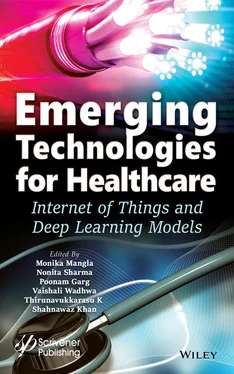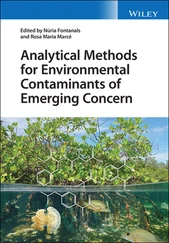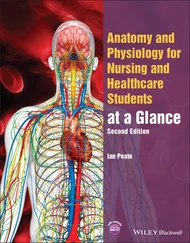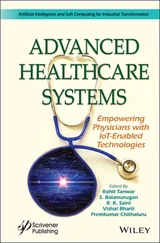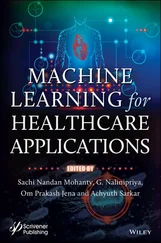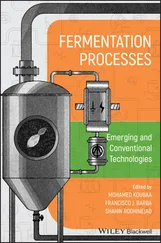1 Cover
2 Title page
3 Copyright
4 Preface
5 Part I BASICS OF SMART HEALTHCARE 1 An Overview of IoT in Health Sectors 1.1 Introduction 1.2 Influence of IoT in Healthcare Systems 1.3 Popular IoT Healthcare Devices 1.4 Benefits of IoT 1.5 Challenges of IoT 1.6 Disadvantages of IoT 1.7 Applications of IoT 1.8 Global Smart Healthcare Market 1.9 Recent Trends and Discussions 1.10 Conclusion References 2 IoT-Based Solutions for Smart Healthcare 2.1 Introduction 2.2 IoT Smart Healthcare System 2.3 Locally and Cloud-Based IoT Architecture 2.4 Cloud Computing 2.5 Outbreak of Arduino Board 2.6 Applications of Smart Healthcare System 2.7 Smart Wearables and Apps 2.8 Deep Learning in Biomedical 2.9 Conclusion References 3 QLattice Environment and Feyn QGraph Models—A New Perspective Toward Deep Learning 3.1 Introduction 3.2 Machine Learning Model Lifecycle 3.3 A Model Deployment in Keras 3.4 QLattice Environment 3.5 Using QLattice Environment and QGraph Models for COVID-19 Impact Prediction References 4 Sensitive Healthcare Data: Privacy and Security Issues and Proposed Solutions 4.1 Introduction 4.2 Medical Sensor Networks/Medical Internet of Things/Body Area Networks/WBANs 4.3 Cloud Storage and Computing on Sensitive Healthcare Data 4.4 Blockchain for Security and Privacy Enhancement in Sensitive Healthcare Data 4.5 Artificial Intelligence, Machine Learning, and Big Data in Healthcare and Its Efficacy in Security and Privacy of Sensitive Healthcare Data 4.6 Conclusion References
6 Part II EMPLOYMENT OF MACHINE LEARNING IN DISEASE DETECTION 5 Diabetes Prediction Model Based on Machine Learning 5.1 Introduction 5.2 Literature Review 5.3 Proposed Methodology 5.4 System Implementation 5.5 Conclusion References 6 Lung Cancer Detection Using 3D CNN Based on Deep Learning 6.1 Introduction 6.2 Literature Review 6.3 Proposed Methodology 6.4 Results and Discussion 6.5 Conclusion References 7 Pneumonia Detection Using CNN and ANN Based on Deep Learning Approach 7.1 Introduction 7.2 Literature Review 7.3 Proposed Methodology 7.4 System Implementation 7.5 Conclusion References 8 Personality Prediction and Handwriting Recognition Using Machine Learning 8.1 Introduction to the System 8.2 Literature Survey 8.3 Theory 8.4 Algorithm To Be Used 8.5 Proposed Methodology 8.6 Algorithms vs . Accuracy 8.7 Experimental Results 8.8 Conclusion 8.9 Conclusion and Future Scope Acknowledgment References 9 Risk Mitigation in Children With Autism Spectrum Disorder Using Brain Source Localization 9.1 Introduction 9.2 Risk Factors Related to Autism 9.3 Materials and Methodology 9.4 Results and Discussion 9.5 Conclusion and Future Scope References 10 Predicting Chronic Kidney Disease Using Machine Learning 10.1 Introduction 10.2 Machine Learning Techniques for Prediction of Kidney Failure 10.3 Data Sources 10.4 Data Analysis 10.5 Conclusion 10.6 Future Scope References
7 Part III ADVANCED APPLICATIONS OF MACHINE LEARNING IN HEALTHCARE 11 Behavioral Modeling Using Deep Neural Network Framework for ASD Diagnosis and Prognosis 11.1 Introduction 11.2 Automated Diagnosis of ASD 11.3 Purpose of the Chapter 11.4 Proposed Diagnosis System 11.5 Conclusion References 12 Random Forest Application of Twitter Data Sentiment Analysis in Online Social Network Prediction 12.1 Introduction 12.2 Literature Survey 12.3 Proposed Methodology 12.4 Implementation 12.5 Conclusion References 13 Remedy to COVID-19: Social Distancing Analyzer 13.1 Introduction 13.2 Literature Review 13.3 Proposed Methodology 13.4 System Implementation 13.5 Conclusion References 14 IoT-Enabled Vehicle Assistance System of Highway Resourcing for Smart Healthcare and Sustainability 14.1 Introduction 14.2 Related Work 14.3 Objectives, Context, and Ethical Approval 14.4 Technical Background 14.5 IoT Infrastructural Components for Vehicle Assistance System 14.6 IoT-Enabled Vehicle Assistance System of Highway Resourcing for Smart Healthcare and Sustainability 14.7 Challenges in Implementation 14.8 Conclusion References 15 Aids of Machine Learning for Additively Manufactured Bone Scaffold 15.1 Introduction 15.2 Research Background 15.3 Statement of Problem 15.4 Research Gap 15.5 Significance of Research 15.6 Outline of Research Methodology 15.7 Conclusion References
8 Index
9 End User License Agreement
1 Cover
2 Table of Contents
3 Title page
4 Copyright
5 Preface
6 Begin Reading
7 Index
8 End User License Agreement
1 Chapter 1 Figure 1.1 Stages of IoT. Figure 1.2 Global market growth.
2 Chapter 2 Figure 2.1 Process flow of smart healthcare application. Figure 2.2 Architecture of IoT-based SHCS [20]. Figure 2.3 Layers of IoT on local server and on cloud server. Figure 2.4 System architect of smart healthcare system. Figure 2.5 Arduino UNO model [44] . Figure 2.6 Smart healthcare system with its dimensions. Figure 2.7 Activation model for deep learning. Figure 2.8 Different deep neural network architectures for biomedical engineerin...
3 Chapter 3Figure 3.1 Machine learning end-to-end process for continuous delivery of ML mod...Figure 3.2 (a) The model visualization plot. (b) Confusion matrix after evaluati...Figure 3.3 The model visualization plot showing dropout and gaussian noise layer...Figure 3.4 Path integrals (a) classical mechanics case. (b) Path integrals showi...Figure 3.5 A Sample QLattice QGraph model for diabetes prediction.Figure 3.6 The best QGraph model extracted for the given diabetes prediction pro...Figure 3.7 The performance plots for the QGraph models. (a) Confusion matrix; (b...Figure 3.8 COVID-19 data plot (actual figures scaled by100,000 on Y-axis).Figure 3.9 Best QGraph model for the COVID-19 global deaths prediction.Figure 3.10 Plot for actual data of global deaths vs. predicted global deaths (r...Figure 3.11 Plot for actual data of COVID-19 pandemic vs. predicted global death...
4 Chapter 4Figure 4.1 How WBSN/WMIOT/WBAN, etc., work? [4].Figure 4.2 Various types of security and privacy needs for WBANs, WMSNs, WMIOTs,...Figure 4.3 KP-ABE and CP-ABE schemes in cloud computing and storage [20].Figure 4.4 Biomedical security system with blockchain [22].
5 Chapter 5Figure 5.1 Proposed methodology.Figure 5.2 Data collection key points.Figure 5.3 Representation of issues resolved by data preparation.Figure 5.4 Different classifiers.Figure 5.5 KNN algorithm.Figure 5.6 SVM classifier.Figure 5.7 Random Forest classifier.Figure 5.8 Graph of sigmoid function.Figure 5.9 Logistic classifier.Figure 5.10 User interaction model.Figure 5.11 System implementation.Figure 5.12 Dataset for model having no null values.Figure 5.13 Dataset for model implementation.Figure 5.14 Data splitter module.Figure 5.15 Building Random Forest model.Figure 5.16 Accuracy score of Random Forest classifier.Figure 5.17 Evaluation metrics of Random Forest classifier.Figure 5.18 Performance of Decision Tree classifier.Figure 5.19 Evaluation metrics of Decision Tree classifier.Figure 5.20 Performance of SVM classifier.Figure 5.21 Evaluation metrics of SVM classifier.
6 Chapter 6Figure 6.1 Proposed methodology.Figure 6.2 Flow chart for preparing 3D CNN.Figure 6.3 Max pooling.Figure 6.4 Flattening.Figure 6.5 Basic flow for system implementation.Figure 6.6 Code snippet for data pre-processing.Figure 6.7 Results of data pre-processing.Figure 6.8 Density of common substances on CT.Figure 6.9 Distinguishing between pixels and air.Figure 6.10 Bone structure.Figure 6.11 Segment lungs.Figure 6.12 Inner lungs structure.Figure 6.13 Code snippet for training and testing the dataset.Figure 6.14 Training results.Figure 6.15 Final output.
7 Chapter 7Figure 7.1 Proposed methodology.Figure 7.2 Different libraries employed for development of proposed model.Figure 7.3 CNN layers.Figure 7.4 CNN basic flow.Figure 7.5 ANN training.Figure 7.6 ANN working algorithms.Figure 7.7 System implementation.Figure 7.8 Code snippet for data pre-processing.Figure 7.9 Data split.Figure 7.10 Model training.Figure 7.11 Model fitting.Figure 7.12 Accuracy curve.Figure 7.13 Loss curve.Figure 7.14 Accuracy and precision matrix.
Читать дальше
